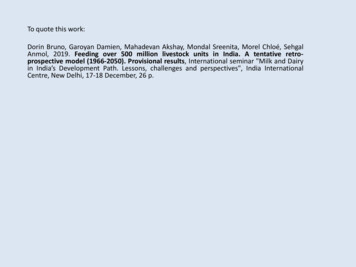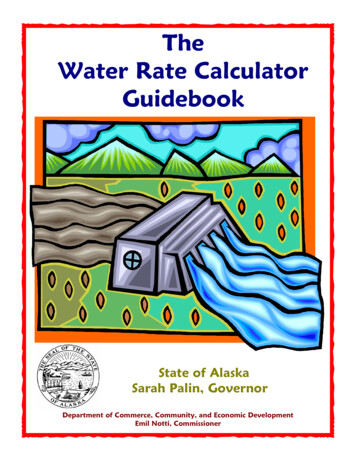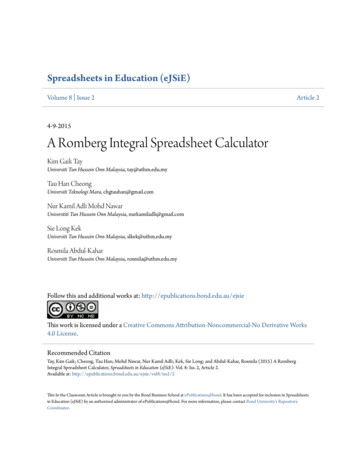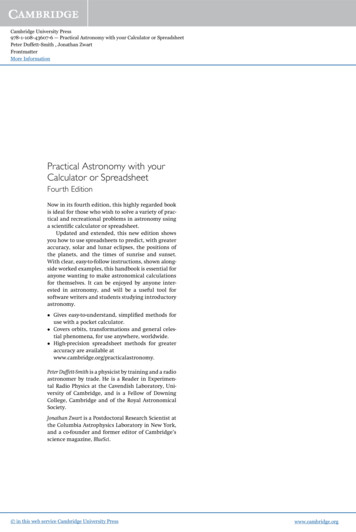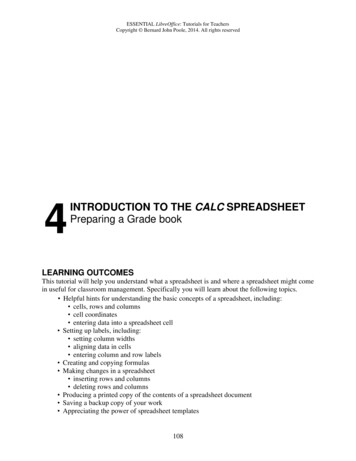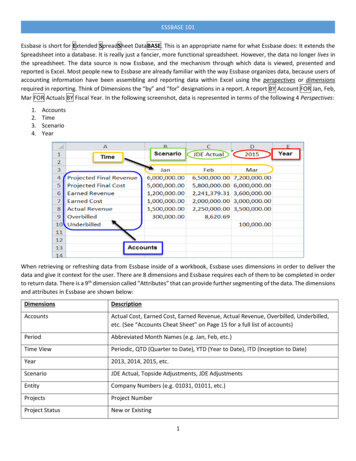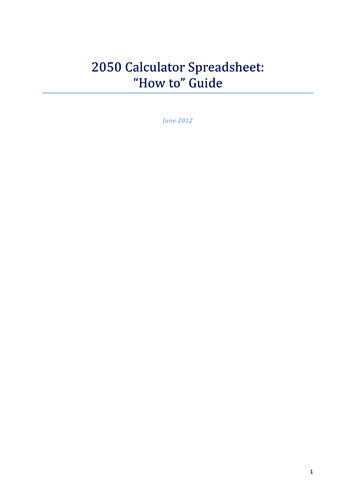
Transcription
2050 Calculator Spreadsheet:“How to” GuideJune 20121
ContentsIntroduction . 3How do I make a pathway in the spreadsheet?. 4How the Calculator works . 5Frequently Asked Questions . 12Emissions questions . 12Why are some emissions negative? . 12Energy supply and demand questions . 13How is biomass allocated across the sectors? . 13How does the Calculator ensure there is sufficient energy supply to meet demand? . 15How do you change the trajectory definitions (e.g. how can I redefine level 4)? . 15Cost questions . 16What discount rate do you use and how do you change it? . 16What finance cost assumptions do you use and how can you change them? . 16Where can you get total costs and cost/person/year? How can you graph these over time? . 17Assumption and data questions . 17How do you change the units? . 17What population figures have you used and how do you change them? . 17What GDP growth rate assumptions have you used and how do you change them? . 17Why are there three 2007 worksheets? . 17Excel specific questions. 17Why can’t I open the spreadsheet in Excel ’97? . Error! Bookmark not defined.What do ‘Index and Match’ formulae do? . 17What is a ‘Structured Table Reference’? . 18Webtool questions . 19How do you paste a pathway between Excel and the web tool? . 19Where can I see key information about my pathway, such as total electricity generation andelectricity capacities, and energy demand for heat and transport?. 192
IntroductionThe UK faces major choices about how to move to a secure, low carbon economy over the period to2050. Should we do more to cut demand, or rely more on increasing and decarbonising the energysupply? How will we produce our electricity? Which technologies will we adopt? The Department ofEnergy and Climate Change’s 2050 Pathway tools help policymakers, the energy industry and thepublic understand these choices.For each sector of the economy, four trajectories have been developed, ranging from little or noeffort to reduce emissions or save energy (level 1) to extremely ambitious changes that pushtowards the physical or technical limits of what can be achieved (level 4). The 2050 Pathways toolsallow users to develop their own combination of level changes to achieve an 80% reduction ingreenhouse gas emissions by 2050, while ensuring that energy supply meets demand. There arethree types of 2050 tool, which range from high detail to low detail. These are as follows:1. The Excel-based 2050 Calculator tackling/2050/calculator exc/calculator exc.aspx2. The online ling/2050/calculator on/calculator on.aspx3. The online My2050 tool:http://my2050.decc.gov.uk/This “2050 Calculator: How To Guide” provides a brief overview of how the more detailed Excelbased 2050 Calculator spreadsheet works (# 1 above) and answers some of the key questions thatusers may have with regard to using this spreadsheet tool. This guide includes: Information on how to make a pathway in the spreadsheet; a series of summary schematics that set out the broad ways in which certain outputs(emissions, energy supply, energy demand, costs, air pollution emissions and land use) areproduced by the Calculator; and answers to some commonly asked questions about the Calculator spreadsheet, withquestions grouped by broad categories. These “frequently asked questions” provide specificdetail on the input assumptions, methodology and outputs of the 2050 Calculatorspreadsheet.This guide does not provide exhaustive detail on all aspects of this Calculator. However, users of the2050 Calculator spreadsheet can find more detail on the public “wiki”, which can be found asfollows: /1. Links to specific wiki pages are givenwithin this guide to provide supporting information to the specific explanations provided. If usershave queries or comments that are not addressed by this guide or by the wiki, then they can addressfurther queries to the 2050 Team, who will do their best to respond. The Team can be contacted atthe following e-mail address: 2050pathways@decc.gsi.go.uk.3
How do I make a pathway in the spreadsheet?Users of the 2050 Calculator spreadsheet (referred to as “the Calculator” from here on) can createtheir own pathway to 2050 as follows:1. Go to the “Control” worksheet and enter your pathway choice into column E. You can ‘copy’and ‘paste’ an example pathway (choosing one from columns M to AB) or enter your own.You can use decimals.2. Press F9 to activate the Calculator3. View the results of your pathway on the “Control” worksheet, from rows AF onwards.4. For tips on how to make a good pathway, see: the “Create your pathway” section 2050/calculator on/calculator on.aspx5. You can paste your pathway from Excel to the Webtool and from the Webtool into Excel(see the answer to “How do you paste a pathway between Excel and the web tool?” below).4
How the Calculator worksThis section provides an overview of how the 2050 Calculator spreadsheet works in broad terms. It iscomposed of a series of figures and tables as follows:1. Figure 1: this shows how the Calculator produces emission, energy supply and energydemand trajectories;2. Figure 2: this shows how the Calculator produces costs;3. Figure 3: this shows how the Calculator produces air quality impacts;4. Figure 4: this shows how the Calculator produces land use impacts;5. Figure 5: this shows how a sector sheet works in the Calculator, using the example ofonshore wind; and6. Table 1: this provides a list of the sectors in the Calculator, the names of their correspondingworksheets and the names of their corresponding levers in the Webtool.5
Figure 1: how the 2050 Calculator produces emission, energy supply and energy demandtrajectoriesWhat it doesWorksheet nameThe user enters their preferredpathway by choosing trajectories (14) for each energy demand and supplysector of the economy.ControlI.a2010I.b2015II.a2020 IntermediateoutputControlXVIII.a2050Sectors have their own mini model,incorporating the required informationto estimate greenhouse gasemissions, energy supplied andenergy used for five year intervals to2050 (a snapshot for each of theseyears) . These worksheets contain themajority of the Calculator’scalculations. Table 1 maps the sectorsin the “control” worksheet (such asnuclear power) to their correspondingsector worksheets (“II.a”) Figure 5provides more detail, using theonshore wind sector worksheet (III.a).The greenhouse gas emissions, energysupplied and energy used from eachsector are gathered together to revealtotal emissions, energy supplied andenergy demanded for each five yearinterval to 2050 (a snapshot for eachof these years). Each of these “year”worksheets follows the samestructure.Total greenhouse gas emissions,energy supplied and energy used foreach year (in five year intervals) arecombined to form time seriestrajectories out to 2050.Charts of the greenhouse gasemissions, energy supplied and energyused to 2050 feed through to thecontrol sheet, which gives graphicalfeedback to the user as they exploretheir preferred trajectories.6
Figure 2: how the 2050 Calculator produces costsWhat it doesWorksheet nameThe user chooses their preferredpathway by choosing trajectories (14) for each energy demand and supplysector of the economy.ControlI.aI.bII.a CostAbsoluteCostPerCapitaXVIII.aSectors have their own mini model,incorporating the required informationto calculate the low, point estimateand high capital, operating and fuelcosts for five year intervals to 2050 (asnap short for each of these years).These worksheets contain themajority of the Calculator’scalculations. Table 1 maps the sectorsin the “control” worksheet (such asnuclear power) to their correspondingsector worksheets (“II.a”) Figure 5provides more detail, using theonshore wind sector worksheet (III.a).The capital, operating and fuel costsare gathered together to reveal costsfor each five year interval to 2050 (asnap shot for each of these years). Thefinance costs for borrowed capital arecalculated in this sheet.The costs in the “CostAbsolute”worksheet are pulled into the“CostPerCapita” worksheet andconverted into costs per capita.More detail on costs can be found on the following website page: 287
Figure 3: how the 2050 Calculator produces air quality impactsWorksheet nameWhat it doesThe user chooses their preferredpathway by choosing trajectories (14) for each energy demand and supplysector of the UK.ControlI.aI.bII.a AQImpactHInvandAQImpactLInvAQ OutputsXVIII.aThe air pollution emissions associatedwith the chosen trajectories arecalculated for each sector. Mostsectors have their own mini model,incorporating the required informationto estimate air pollution emissions forfive year intervals to 2050 (a snap shotfor each of these years).Total air pollution emissions for eachof the sectors are combined to form atime series of air pollution emissionsto 2050, under high and low pollutionabatement (“innovation”) scenarios.Pollution in each five year period isconverted into human life years thatare lost to pollution.An index of air pollution healthimpacts is produced. This shows theimpact in 2050 of the chosenpathway’s air quality impact on humanhealth, compared with the impact oftrajectory 1 effort in all sectors.More detail on air quality impacts can be found on the following website page: 808
Figure 4: how the 2050 Calculator produces land use impactsWorksheet nameThe user chooses their preferredpathway by choosing trajectories (14) for each energy demand and supplysector of the economy.ControlI.aI.bII.aLandUseWhat it does XVIII.aSectors have their own mini model,incorporating the required informationto calculate the land use impacts forfive year intervals to 2050 (a snap shotfor each of these years). Theseworksheets contain the majority ofthe Calculator’s calculations. Table 1maps the sectors in the “control”worksheet (such as nuclear power) totheir corresponding sector worksheets(“II.a”). Figure 3 provides more detail,using the onshore wind sectorworksheet (III.a).The land use impacts across eachsector are gathered together to revealtotal land use impacts to 2050. Thisincludes impacts on: UK land area; UKsea area; and overseas land areausage.9
Figure 5: how a sector worksheet works (onshore wind example)ExplanationSector worksheetIII.a.1 Onshore windThe onshore wind trajectory selected on the Controlworksheet.Choice of TrajectoryComponentTrajectoryTrajectory1Trajectory assumptionsOnshore wind, new buildTrajectory 01.601.52GW per annum, for subsequent period; nameplate capacity20200.551.000.760.76Trajectory Description20150.550.7634Onshore wind, 0)(2.50)--Fixed assumptionsassumptionsLegacy capacity (built prior to end 2007)FuelPlant typeNotesR.02Capacity factorOnshore wind[1]FuelPlant typeNotesR.02Onshore 027.3%30%30%30%30%30%30%30%30%30%2.1UnitAssumed typical turbine sizeTranchesEnergy/unit of areaCummulative GW1124482Fixed assumptions underlying the model, including; theexisting onshore wind capacity at end 2007, the capacityfactor (the percent of time the facility is active), thecapacity of a single wind turbine and the energy outputper square kilometre of onshore wind.0.022 TWh/km 2243Notes0.0025 GWpeak[3]The build (and retirement) rates associated with thefuture numbers of wind turbines specified in theselected trajectories.GW per annum, for subsequent period; nameplate .001.602.5012Chosen201036[1] Source for 2007 data: DUKES 2009, Tables 5.7, 5.10, and 7.4.Includes all power producers (not just major power producers)[2] Capacity factor assumes no energy spilled2007 capacity factor taken to be 2007 load factor (on an unchanged configuration basis; see DUKES Table 7.4)Post 2007 figures are 2008 figures, assumed to be constant[3] Equivalent to a 2.5W/m2 actual energy outputCost assumptionsCapital cost of a 0.0025 GW wind turbine m/turbineHigh estimatePoint estimateLow .1Operating cost of a 0.0025 GW wind turbineHigh estimatePoint estimateLow estimate2050532 m/turbineDerived assumptionsTotal wind capacityFuelDescriptionR.02Onshore windOnshore windInstalled capacity Capacity factor Available supplyGenerationFor information:Approximate total 2.5 MW turbinesApproximate build rate of 2.5 MW turbinesApproximate land area coveredHigh estimate of costsCapital costsOperating costsTotal costsoutputsPoint estimate of costsCapital costsOperating costsTotal costsLow estimate of costsCapital costsOperating costsTotal costsOutputsNotesGWTWhGW##/yrkm 1,3223,3139942,2136641,113334134134 m m 28261,8486216214154152092093333 m m 638380000 m m 000Energy produced and requiredVectorNameV.02Electricity (supplied to )-0.1(0.1)-B.01B.02B.03onshore wind if 2.5 W/m2Installed peak capacityNoteskm 2GWApproximate number if 2.5 MW 4.00.01,1130.01313CostsCosts of this physical changeVectorNameC1.LowLow estimate of capital costsC2.LowC1.PointC2.PointC1.HighC2.HighLow estimate of operating costsPoint estimate of capital costsPoint estimate of operating costsHigh estimate of capital costsHigh estimate of operating -76.3415.02045-19.5-38.4208.82050-0.2-0.52.5The energy generation total calculated above ispresented in a structured table format.-Information summaryInformation typeTotal generation is calculated by multiplying theinstalled capacity by the capacity factor. The number ofnew and existing turbines in each period is calculated.Capital costs are calculated by multiplying the perturbine cost by the number of new turbines in eachperiod. Operating costs are calculated by multiplying theper turbine cost by the total number of turbines existingin each period.(0.1)-InformationVectorHigh, low and point cost estimates for each turbine in2007 and 2050 used to calculate a cost delta. This isthen used to estimate the costs for the intervening fiveyear periods. The same process is used for both capitalcosts and operating costs.-0.2-The total required area, installed capacity and numberof onshore turbines are presented in a structured tableformat.The high, low and point estimates for capital andoperational costs are presented in a structured tableformat.0.52.510
Table 1: 2050 Calculator sectors and leversEnergy supply sectorsWorksheet name Lever in webtoolNuclear powerCarbon Capture Storage (CCS)II.aI.bOffshore windOnshore windIII.a.2III.a.1WaveIII.c.WaveTidal StreamIII.c.TidalStreamTidal RangeIII.c.TidalRangeBiomass/Coal power stationsSolar PVSolar thermalGeothermal electricityHydroelectric power stationsSmall-scale windElectricity importsAgriculture and land useI.aIV.aIV.bIII.dIII.bIV.cVII.aVI.aVolume of Waste & RecyclingMarine algaeTypes of fuel from BiomassBioenergy importsVI.bVI.cV.aV.bNuclear power stationsCarbon Capture Storage (CCS)CCS power stationsCCS power station fuel mixOffshore windOnshore windWaveTidal StreamTidal RangeBiomass power stationsSolar panels for electricitySolar panels for hot waterGeothermal electricityHydroelectric power stationsSmall-scale windElectricity importsAgriculture and land useLand dedicated to bioenergyLivestock and their managementVolume of waste and recyclingMarine algaeType of fuels from biomassBioenergy importsEnergy demand sectorsDomestic passenger transportXII.aDomestic freightInternational aviationInternational shippingDomestic space heating and hot waterXII.bXII.cXII.eIX.aDomestic lighting, appliances, and cookingX.aIndustrial processesXI.aCommercial heating and coolingIX.cCommercial lighting, appliances, and catering X.bOtherGeosequestrationStorage, demand shifting, interconnectionIndigenous fossil-fuel productionXIV.aVII.cXV.bDomestic passenger transportDomestic transport behaviourShift to zero emission transportChoice of fuel cells or batteriesDomestic freightInternational aviationInternational shippingDomestic space heating and hot waterAverage temperature of homesHome insulationHome heating electrificationHome heating that isn't electricDomestic lighting, appliances, and cookingHome lighting & appliancesElectrification of home cookingIndustrial processesGrowth in industryEnergy intensity of industryCommercial heating and coolingCommercial demand for heating and coolingCommercial heating electrificationCommercial heating that isn't electricCommercial lighting, appliances, and cateringCommercial lighting & appliancesElectrification of commercial cookingGeosequestrationStorage, demand shifting & interconnectionIndigenous fossil-fuel production11
Frequently Asked QuestionsThis section provides answers to frequently asked questions (FAQs) about the 2050 Calculatorspreadsheet. This list of FAQs is not intended to be a complete list, and more questions and answerscan be found on the public wiki as follows: /47and /115. The FAQs are grouped under broadcategories as follows: Emissions questions; Energy supply and demand questions; Cost questions; Assumption and data questions; Excel specific questions; and Webtool questions.Emissions questionsWhy are some emissions negative?In the emissions chart in the “Control” worksheet, you will see that some emissions are negative.The technologies that have particular characteristics that result in negative emissions are as follows: Carbon capture and storage (CCS) – when gas is burned in a CCS power station, theCalculator applies the natural gas emissions factor to the quantity burned and adds theresulting CO2 to the model’s total emissions. To account for the fact that these emissionsare captured, an equivalent negative quantity of emissions is also added to the total. Biomass – like all other fuels, when biofuels’ biomass are combusted, the model applies anemissions factor according to its physical state. However, unlike hydrocarbons, biofuels donot produce any CO2 when burned. UNFCCC accounting guidelines state that countriesshould treat biomass as an emissions neutral energy source. This is because carbon from theatmosphere is sequestered into the biomass while the feedstock is growing. To account forthis, an equivalent negative quantity of emissions is included in the emission calculation.When biofuels are combined with CSS, the above treatments combine, resulting in anegative contribution to the overall CO2 emission calculation. Geosequestration - these technologies remove CO2 directly from the atmosphere and storeit in parts of the geochemical system. The amount of CO2 removed appears as a negativequantity in the emissions calculation.12
Energy supply and demand questionsHow is biomass allocated across the sectors?Biomass is produced in the spreadsheet as a result of a combination and interaction of user choicesacross a number of sectors. The user specifies the amount of domestically produced biomass andhow they want this to be converted into different forms (a mix of gaseous, liquid and solid). This iscombined with imported biomass to provide the total available biomass. This total biomass is thenused up by the sectors that use the corresponding end use forms of fuel. The process works asfollows: Domestically produced biomass: the quantity of domestically produced biomass isdetermined by the user’s choices in the following sectors in the “Control” worksheet:o“land dedicated to bioenergy”, cell E22 (with calculations performed in worksheet“V.1a”);o“livestock and their management”, cell E23 (with calculations performed inworksheet “V.1a”);o“marine algae”, cell E25 (with calculations performed in worksheet “V.1c”); ando“volume of waste and recycling”, cell E24 (with calculations performed in worksheet“V.1b”). Imported biomass: biomass imports are determined by the user in the “Control” worksheet,cell E27 (with calculations performed in worksheet “V.b”). Converting total biomass into solid, liquid or gaseous forms: domestically produced biomassis combined and drawn into the worksheet “V.a” as either dry or wet biomass and waste,gaseous waste or first or second generation energy crop inputs. The biomass is convertedinto either solid, liquid or gaseous hydrocarbons, depending on the trajectory specified inthe “type of fuels from biomass” trajectory in cell E26 in the “Control” worksheet. Someenergy is lost in the conversion process. The net gaseous, liquid and solid biomass, alongwith the imported biomass (outlined above), gives total biomass in different forms. Uses of biomass: The Calculator assumes that solid biomass can be used in any situation thatuses coal (such as a coal power station), liquid biomass can be used in any situation that usesoil (such as a car engine), and gaseous biomass can be used in any situation that uses naturalgas (such as heating). Each sector can only use specific forms of energy (such as electricity orliquid hydrocarbons), and these are denoted in each sector’s worksheet in the “Outputs:energy produced and required” section. For example, the sectors (and their worksheets)that use liquid hydrocarbons are as follows:oooooooobiomass/coal power stations (“I.a”);agriculture and waste (“VI.a”);domestic space heating and hot water (“IX.a”);commercial heating and cooling (“IX.c”);industrial processes (“XI.a”);domestic passenger transport (“XII.a”);domestic freight (“XII.b”);international aviation (“XII.c”);13
ooointernational shipping (“XXI.e”);fossil fuel production (“XV.a”); andfossil fuel transfers (“XVA.a”).When the user selects options that need a solid fuel in the Calculator, the fuels available areused up in a particular order, as follows: domestic biomass and imported biomass; thendomestic coal; and finally imported coal. If a preferential fuel type is not available then theCalculator uses the next type. The same order of preference is assumed for oil and liquidbiomass and for natural gas and gaseous biomass, where biomass is used ahead of fossil fuelsources when it is available.This order of this consumption can be seen in each of the “year” worksheets, as highlightedas follows with an example from the “MARKAL 3.26 Analog” pathway (which can be selectedin the “Control” worksheet by ‘copying’ and ‘pasting’ column T into column E). oIn worksheet “2050”, the “MARKAL 3.26 Analog” pathway has 134 TWh of liquidbiomass in 2050 available to distribute among the end use sectors that require liquidhydrocarbons, as shown in cell V99 (total liquid biomass is the sum of cell O384 inthe “V.a” worksheet and cell O108 in the “V.b” worksheet).oThe total demand for liquid hydrocarbons from the sectors in 2050 is 538 TWh (cellV95 in the “2050” worksheet).o404 TWh of non-bio liquid hydrocarbons are “requested” by the model andconsumed, which is the difference between the amount of bio and the amountconsumed. This is given in cell V104.Allocation of biomass to sectors: Therefore the Calculator does not allocate biomass tospecific sectors. The Calculator determines the total demand for each fuel type (such asliquid hydrocarbons) by summing the demand across all sectors. The Calculator then ensuresthat there is sufficient supply to meet this demand, subject to the choices made by the userof the Calculator (see above “uses of biomass” and the FAQ “How does the Calculatorensure there is sufficient energy supply to meet demand?” below). The biomass supply thatis determined by the user, as outlined above, is allocated to meet the total demand.The process outlined above is outlined below in Figure 6.14
Figure 6: summary of biomass arising, inter-conversion and end use fuel destinationsHow does the Calculator ensure there is sufficient energy supply to meet demand?The Calculator ensures that any excess demand for solid, liquid and gaseous fuels over and abovedomestic sources and user defined imports (“Electricity imports” in worksheet “VII.a” and “bionergyimports” in worksheet “V.b”) are met by imports in the form of coal, oil and petroleum products andgas. Those calculations are carried out in the worksheets labelled “2007”, “2010”, “2015”, “2020”,“2025”, “2030”, “2035”, “2040”, “2045” and “2050”, in the “balancing imports” line at row 103. Theimports in these worksheets are brought into the “balancing imports” worksheet “XVI.b”. The modeldoes not assume any limit to the quantity of each fuel that could be imported.How do you change the trajectory definitions (e.g. how can I redefine level 4)?Each sector has a dedicated worksheet (for example, hydrocarbon fuel generation is in a worksheetcalled “I.a”). For each sector, the trajectories are defined near the top of the worksheet under a“trajectory assumptions” heading and marked in orange. The trajectories can be redefined bychanging the values in each of the rows against each of the trajectories. For example, trajectory 4 ofthe installed biomass capacity can be amended by changing cells G27 to O27 in the hydrocarbon fuelgeneration worksheet “I.a”.15
Levels 1 to 4 are designed to cover a broad range of possibilities and to test the boundaries of whatmight be possible. They are intended to reflect the whole range of potential futures that might beexperienced in each sector. They are illustrative and are not based on assumptions about futurepolicy and its impacts, and should not be interpreted as such. These levels were agreed following anextensive call for evidence in Summer 2010 and represent a shared view between the UKGovernment, businesses, academics and green groups on the minimum and maximum effort acrosssectors. Users are of course free to change these trajectories but they should bear in mind where thelevel definitions came from.Cost questionsWhat discount rate do you use and how do you change it?The discount rate is set at a default rate of 3.5% for the years 2010 to 2040 and at 3.0% in followingyears, which follows HM Treasury “Green Book” guidance (http://www.hmtreasury.gov.uk/d/green book complete.pdf). A more detailed explanation for why we chose thesedefault discount rates can be found on the public “wiki” /107).To change the discount rates, open the 2050 “Global assumptions” worksheet in the “2050Calculator” workbook, and change the values in cells C27 to K27.What finance cost assumptions do you use and how can you change them?The default finance cost assumptions (the co
3. Figure 3: this shows how the Calculator produces air quality impacts; 4. Figure 4: this shows how the Calculator produces land use impacts; 5. Figure 5: this shows how a sector sheet works in the Calculator, using the example of onshore wind; and 6. Table 1: this provides a list of the sectors in the Calculator, the names of their corresponding
